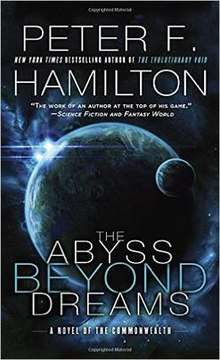The Abyss Beyond Dreams
The Abyss Beyond Dreams is a science fiction novel by the British author Peter F. Hamilton. The book, which was released on 21 October 2014, is the first of the two-part The Chronicle of the Fallers.
 First edition cover | |
| Author | Peter F. Hamilton |
|---|---|
| Illustrator | Chester Orwell |
| Country | United Kingdom |
| Language | English |
| Series | The Chronicle of the Fallers |
| Genre | Science fiction novel |
| Publisher | Pan Macmillan (UK) Del Rey Books (US) |
Publication date | 21 October 2014 |
| Media type | Print (hardcover) Audiobook |
| Pages | 640 |
| ISBN | 978-0345547194 |
| OCLC | 886382210 |
| Followed by | Night Without Stars |
Background
Hamilton announced in 2011 that he was developing a new trilogy.[1] He later decided to cut the trilogy down to two parts.[2] Cover art for The Abyss Beyond Dreams was unveiled on March 19, 2014.[3] The book was published by Pan Macmillan in October 2014. Its sequel is Night Without Stars.
Synopsis
The novel returns to Hamilton's far-future Commonwealth universe in the 34th century, in the time following the events of the Void Trilogy. It features Nigel Sheldon, the posthuman co-inventor of wormhole technology, who enters the hostile alien pocket universe known as the Void to find a way of destroying it. In the process, he lands on the planet Bienvenido, which is home to a stranded human civilisation under constant attack by adaptive aliens known as Fallers. A second storyline follows Slvasta, a young soldier, as he progresses from fighting on the front-line against the Fallers to becoming more involved in Bienvenido's politics and government.
Setting
The Void, created at the centre of the Milky Way galaxy by an ancient alien race, has a different quantum structure from that of a normal space. The Void reacts to conscious thought, but prevents the use of most electric and electronic devices, although most newly arrived equipment functions initially and only degrades over a period of time. Technology on Bienvenido is generally limited to a 19th-century or early 20th-century level, including steam engines, municipal water supplies and an extensive railway transportation network, but no long-distance communication such as radio or telegraphy. On the other hand, all humans and other sapient beings in the Void possess telekinesis and mental telepathy capabilities, and retain their knowledge of more advanced technology. Biotechnology also largely resists the Void's effects, allowing Nigel Sheldon to bring a team of powerful androids into the Void with him.
Reception
On Goodreads, it holds a 4.2 out of 5, based on over 10,000 votes.[4]
References
- "May 2011" Archived 2014-06-05 at the Wayback Machine. PeterFHamilton.co.uk. Retrieved December 18, 2014.
- "Interview with Peter F. Hamilton". GeekChocolate.co.uk. October 15, 2012. Retrieved December 18, 2014.
- "The Abyss Beyond Dreams cover art" Archived 2014-10-17 at the Wayback Machine. Upcoming4.me. Retrieved December 18, 2014.
- "The Abyss Beyond Dreams". Goodreads. Retrieved 2018-12-14.